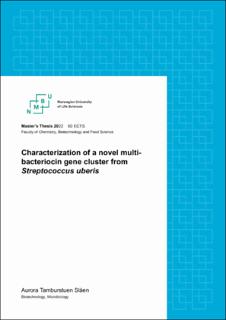| dc.contributor.advisor | Oftedal, Thomas | |
| dc.contributor.advisor | Diep, Bao Dung | |
| dc.contributor.author | Slåen, Aurora Tamburstuen | |
| dc.date.accessioned | 2022-11-21T11:49:41Z | |
| dc.date.available | 2022-11-21T11:49:41Z | |
| dc.date.issued | 2022 | |
| dc.identifier.uri | https://hdl.handle.net/11250/3033127 | |
| dc.description.abstract | Bovine mastitis is a common disease among dairy cattle and causes large economic losses worldwide as a result of low yield and poor quality of milk. Antibiotics have long been used to treat dairy cattle from mastitis, but as resistance of antibiotics is an increasing issue, there is a need of alternatives to treatment. Bacteriocins are a possible solution to the bovine mastitis problem. Bacteriocins are ribosomaly synthesized peptides produced by bacteria, that targets other strains of bacteria.
Previously, screening after bacteriocins that targets bovine mastitis pathogens have been conducted. The bacteriocin ubericin K was identified from the strain Streptococcus uberis LMGT 4124 from milk samples. In the same operon there was also two other potential bacteriocins in addition to ubericin K, one potential class IIb bacteriocin, encoded by orf6 and orf7, and one potential class IId bacteriocin encoded by orf13. Putative promoters with a pair of direct repeats are located upstream of both orf6/7 and orf13, indicating that they might be regulated. In addition, the ubericin K cluster encode a two-component regulatory system and a putative pheromone, which together might constitute a quorum-sensing system. The aim of this project was to identify these two bacteriocins and determine their antimicrobial spectrum and investigate the activity of the promoters and the regulatory role of the sequence elements and pheromone.
It was found by in vitro synthesis of the potential bacteriocins that they have antimicrobial activity and can therefore conclude that they are active bacteriocins. Since these bacteriocins were not possible to purify from the producer strain, it indicates that the conditions used are not favorable for bacteriocin production. To see if bacteriocin production was affected by the pheromone, synthetic pheromone was added to culture of the producer strain and used for bacteriocin purification. This resulted in two distinct peaks in the elution profile from reversed-phase chromatography that was not observed by earlier work. However, no antimicrobial activity was found in fractions corresponding to the second peak and the first peak correspond well with the expected elution characteristic reported for ubericin K.
Expression of the bacteriocins in Lactococcus lactis was also tried, using both the putative leader sequences and the leader sequence of lactococcin A, however expression was not achievable. Since expression of ORF6/7 and ORF13 was not attainable, only ubericin K was tested against mastitis pathogens isolated from Norwegian farms and it showed promising antimicrobial activity against S. uberis.
To determine the activity of the promoters and the regulatory role of the sequence elements a promoter reporter assay was conducted. Constructs were made where Porf12 was placed upstream of the reporter genes sfGFP (superfolding GFP) and luc (firefly luciferase). Additionally, a mutated variant (PmutRE) was created where the overlapping repeat was replaced with a randomized sequence having the same GC-content. Unfortunately, transformation of the constructs into the producer strain S. uberis LMGT 4124 was unsuccessful.
In conclusion, ORF6/7 and ORF13 is active bacteriocins when synthesized in vitro, but were unable to express them in S. uberis LMGT 4124, with or without the pheromone added or in L. lactis IL1403 with their own leader sequence or lactococcin A leader sequence. Ubericin K targets primarily S. uberis mastitis pathogens and is a promising solution to bovine mastitis. | en_US |
| dc.description.abstract | Bovin mastitt er en vanlig sykdom blant melkekyr og forårsaker store økonomiske tap over hele verden, som følge av lavt utbytte og dårlig melkekvalitet. Antibiotika har lenge vært brukt for å behandle melkekyr mot mastitt, men siden antibiotikaresistens er et stadig økende problem, er det et behov for alternativer til behandling. Bakteriociner er en mulig løsning på problemet med mastitt hos storfe. Bakteriociner er ribosomalt syntetiserte peptider produsert av bakterier, som retter seg mot andre stammer av bakterier.
Det har tidligere blitt utført screening etter bakteriociner som er aktive mot patogener av bovin mastitt. Bakteriocinet ubericin K ble identifisert fra stammen Streptococcus uberis LMGT 4124 fra melkeprøver. I samme operon ble det også funnet to andre potensielle bakteriociner i tillegg til ubericin K, ett potensielt klasse IIb bakteriocin, kodet av orf6 og orf7, og ett potensielt klasse IId-bakteriocin kodet av orf13. Putative promotere med et par direkte repetisjoner er lokalisert oppstrøms for både orf6/7 og orf13, noe som indikerer at de kan være regulert. I tillegg koder ubericin K operonet for et to-komponent regulatorisk system og et mulig feromon, som sammen kan utgjøre et quorum-sensing system. Målet med dette prosjektet var å identifisere disse to bakteriocinene og bestemme deres antimikrobielle spektrum og undersøke aktiviteten til promotorene og den regulerende rollen til sekvenselementene og feromonet. | en_US |
| dc.language.iso | eng | en_US |
| dc.publisher | Norwegian University of Life Sciences, Ås | en_US |
| dc.rights | Attribution-NonCommercial-NoDerivatives 4.0 Internasjonal | * |
| dc.rights.uri | http://creativecommons.org/licenses/by-nc-nd/4.0/deed.no | * |
| dc.title | Characterization of a novel multi-bacteriocin gene cluster from Streptococcus uberis | en_US |
| dc.type | Master thesis | en_US |
| dc.description.localcode | M-BIOTEK | en_US |

